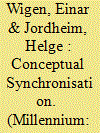|
|
|
Sort Order |
|
|
|
Items / Page
|
|
|
|
|
|
|
| Srl | Item |
| 1 |
ID:
159797


|
|
|
|
|
| Summary/Abstract |
International order is also temporal order, based on the alignment, more precisely, the synchronisation of the multiple times at work on a global scale. Synchronicity between cultures, languages, and polities does not emerge by itself. To create temporal orderings on a global scale requires work: political, social, and linguistic. Some work of synchronisation is performed by technological innovations such as clocks, trains, telegraph lines, phones, satellites etc. Another set of tools, however, is linguistic, made up by concepts used to make historical and political time understandable and workable. Concepts are used to order events, objects and polities temporally, thus making both them and their temporality aspects of international order. By drawing together experiences, events, and meanings from different knowledge fields or cultures, they synchronise them, aligning their speeds, rhythms, and durations. One of the most central concepts that have been used in synchronisation over the past two centuries is progress. In this article we map out how it has synchronised temporalities on a global scale, and ask whether progress is in the process of being replaced by the concept of crisis as the main tool for synchronising temporalities in international society – using examples from political and administrative rhetoric as well as anthropological studies.
|
|
|
|
|
|
|
|
|
|
|
|
|
|
|
|
|
|
|
|
|